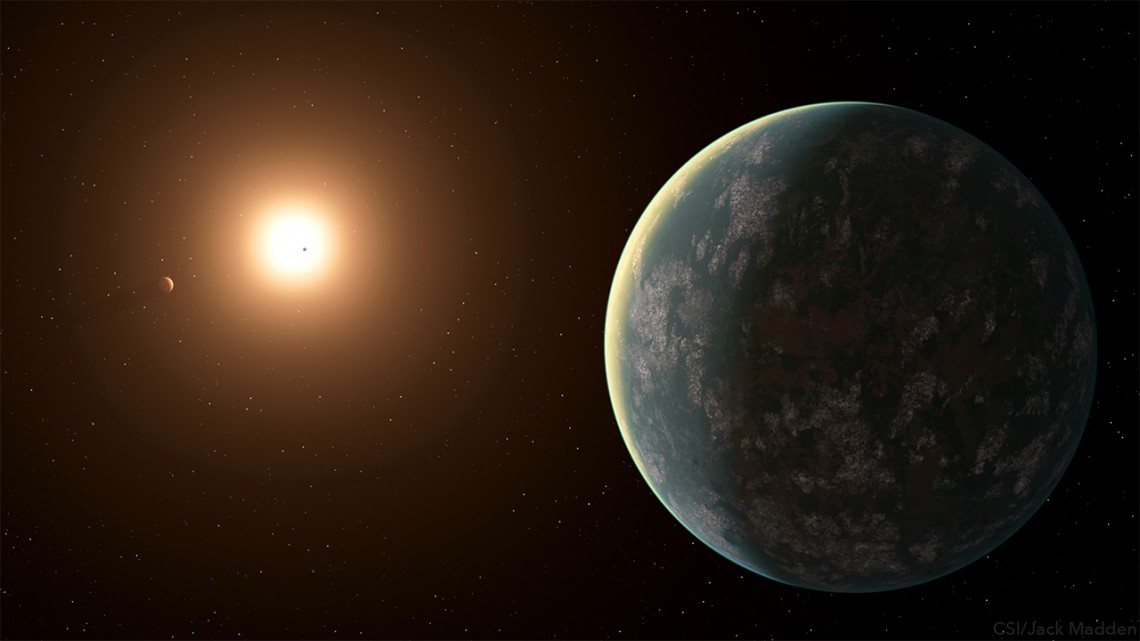
Only 31 light-years away from Earth, the exoplanet GJ 357 d catches light from its host star GJ 357, in this artistic rendering.
TESS satellite uncovers its ‘first nearby super-Earth’
By Blaine Friedlander
An international team of astronomers led by Cornell’s Lisa Kaltenegger has characterized the first potentially habitable world outside of our solar system discovered by NASA’s Transiting Exoplanet Survey Satellite (TESS).
Located about 31 light-years away, the super-Earth planet – named GJ 357 d – was discovered in early 2019 owing to TESS, a mission designed to comb the heavens for exoplanets, according to their new modeling research in the Astrophysical Journal Letters.
“This is exciting, as this is TESS’s first discovery of a nearby super-Earth that could harbor life – TESS is a small, mighty mission with a huge reach,” said Kaltenegger, associate professor of astronomy, director of Cornell’s Carl Sagan Institute and a member of the TESS science team.
The exoplanet is more massive than our own blue planet, and Kaltenegger said the discovery will provide insight into Earth’s heavyweight planetary cousins. “With a thick atmosphere, the planet GJ 357 d could maintain liquid water on its surface like Earth, and we could pick out signs of life with telescopes that will soon be online,” she said.
Astronomers from the Institute of Astrophysics of the Canary Islands and the University of La Laguna, both in Spain, announced the discovery of the GJ 357 system July 31 in the journal Astronomy & Astrophysics. They showed that the distant solar system – with a diminutive M-type dwarf sun, about one-third the size of our own sun – harbors three planets, with one of those in that system’s habitable zone: GJ 357 d.
Last February, the TESS satellite observed that the dwarf sun GJ 357 dimmed very slightly every 3.9 days, evidence of a transiting planet moving across the star’s face. That planet was GJ 357 b, a so-called “hot Earth” about 22% larger than Earth, according to the NASA Goddard Space Flight Center, which guides TESS.
Follow-up observations from the ground led to the discovery of two more exoplanetary siblings: GJ 357 c and GJ 357 d. The international team of scientists collected Earth-based telescopic data going back two decades – to reveal the newly found exoplanets’ tiny gravitational tugs on its host star, according to NASA.
Exoplanet GJ 357 c sizzles at 260 degrees Fahrenheit and has at least 3.4 times Earth’s mass. However, the system’s outermost known sibling planet – GJ 357 d, a super-Earth – could provide Earth-like conditions and orbits the dwarf star every 55.7 days at a distance about one-fifth of Earth’s distance from the sun. It is not yet known if this planet transits its sun.
Kaltenegger, doctoral candidate Jack Madden and undergraduate student Zifan Lin ’20 simulated light fingerprints, climates and remotely detectable spectra for a planet that could range from a rocky composition to a water world.
Madden explained that investigating new discoveries provides an opportunity to test theories and models. “We built the first models of what this new world could be like,” he said. “Just knowing that liquid water can exist on the surface of this planet motivates scientists to find ways of detecting signs of life.”
Lin described the work from an undergraduate perspective: “Working on a newly discovered planet is something of a dream come true. I was among the first group of people to model its spectra, and thinking about this still overwhelms me.”
In a nod to her institute’s namesake, the late Cornell professor Carl Sagan, Kaltenegger said: “If GJ 357 d were to show signs of life, it would be at the top of everyone’s travel list – and we could answer a 1,000-year-old question on whether we are alone in the cosmos.”
In addition to Kaltenegger, Madden and Lin, co-authors of “The Habitability of GJ 357d: Possible Climates and Observability,” include Sarah Rugheimer, Oxford University; Antigona Segura, National Autonomous University of Mexico (UNAM); Rafael Luque and Eric Pallé, both of the Institute of Astrophysics of the Canary Islands and the University of La Laguna; and Néstor Espinoza, Max Planck Institute for Astronomy, Germany.
Media Contact
Get Cornell news delivered right to your inbox.
Subscribe